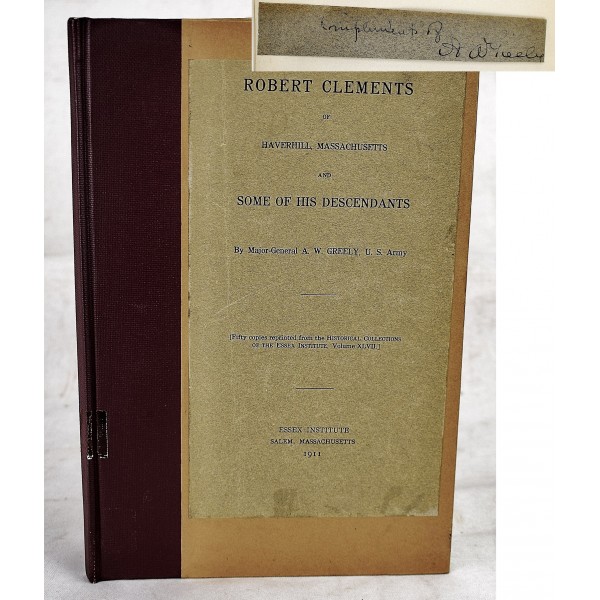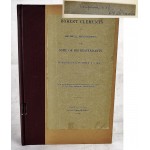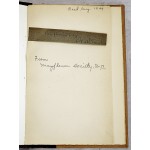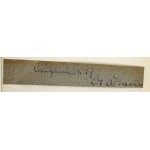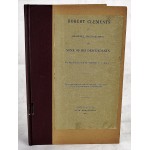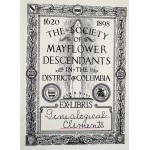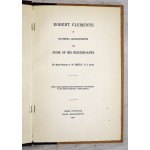Robert Clements of Haverhill, Massachusetts and Some of his Descendants (Signed)
Robert Clements of Haverhill, Massachusetts and Some of his Descendants (Signed)
Greely, Adolphus Washington
Essex Institute, 1911
Inscribed by Major-General A.W. Greeley on in-laid slip. From the library of the Mayflower Society. Bound in publisher's cloth. Paper label on front board. Hardcover. Good binding and cover. Library stamps and markings. Shelf wear. 16 p., 25 cm.
"Adolphus Washington Greely (1844-1935) enlisted in the 19th Massachusetts Volunteer Infantry and served throughout the Civil War, seeing action in several major battles, sustaining serious wounds on three occasions and rising in rank from private to Brevet Major of Volunteers. In March 1867 he entered the Regular Army as a Second Lieutenant in the 36th Infantry. He was promoted to First Lieutenant of Cavalry, May 1873 and served mainly in the West and in Washington, D.C. In 1881 he volunteered for a scientific expedition to the Arctic being planned by the Army according to recommendations of the 1879 International Polar Geographical Conference, which had designated 1882-83 as the first International Polar Year. He was placed in command of a 25-man party sent to establish a meteorological station and sailed in July from Newfoundland aboard the USS Proteus and in August landed at Lady Franklin Bay on the eastern shore off Ellesmere Island. There he established his base camp, Fort Conger, where detailed meteorological and geophysical observations were carried out and from which exploratory expeditions set out for the interior, discovering Lake Hazen and, on the eastern coast, Greely Fjord, and in May 1882 reaching their furthest point north, 83 degrees, 24 minutes. Supply and relief ships set out in 1882 and in 1883 but failed to reach Fort Conger. In August 1883, by prior arrangement, he and his men broke camp and made their way south by boat to Cape Sabine, beyond which they could not go. With dwindling provisions they wintered there, and by the time relief arrived in June 1884 (USS Thetis, USS Bear and USS Alert, all under the command of Commander Winfield Scott Schley) they were left only Greely and six others, one of whom died shortly thereafter. Although he was publicly criticized at first, it eventually became clear that, given his explicit orders and sheer physical necessity, performed correctly and courageously throughout the ordeal. He was promoted to Captain in June 1886. He became by order of President Grover Cleveland a Brigadier General and Chief of the Signal Corps of the Army in March of the following year. In that post, he was responsible over the next 20 years for construction of tens of thousands of miles of telegraph lines and submarine cables in Puerto Rico, Cuba, the Philippines, Alaska and elsewhere, and for the Army's earliest adoption of wireless telegraphy. He was also head of the Weather Service until it was transferred to the Department of Agriculture in 1891. He was a delegate to the International Telegraph Conference in London and the International Wireless Telegraph Congress in Berlin in 1903. In February 1906 he was promoted to Major General and placed in command of the Northern Division. He was later transferred to the Pacific Division and there oversaw relief operations following the San Francisco earthquake in that year. He retired from the Army in 1908. He was widely honored for scientific work and was belatedly awarded the Medal of Honor, in accordance with a Special Act of Congress of March 21, 1935, at his home for "his life of splendid service." He was a founder of the National Geographic Society. He was the only volunteer private to attain the rank of Brigadier and Major General in the Regular Army." - Arlington National Cemetery <br> Founded in 1897, the Mayflower Society, or General Society of Mayflower Descendants is a non-profit organization. Membership requires proof of lineage from one of the passengers who traveled to America on the Mayflower in 1620. Their educational mission includes telling the story of the Pilgrims as well as maintaining the highest standards possible for genealogy research into the lineage of the Pilgrims.
